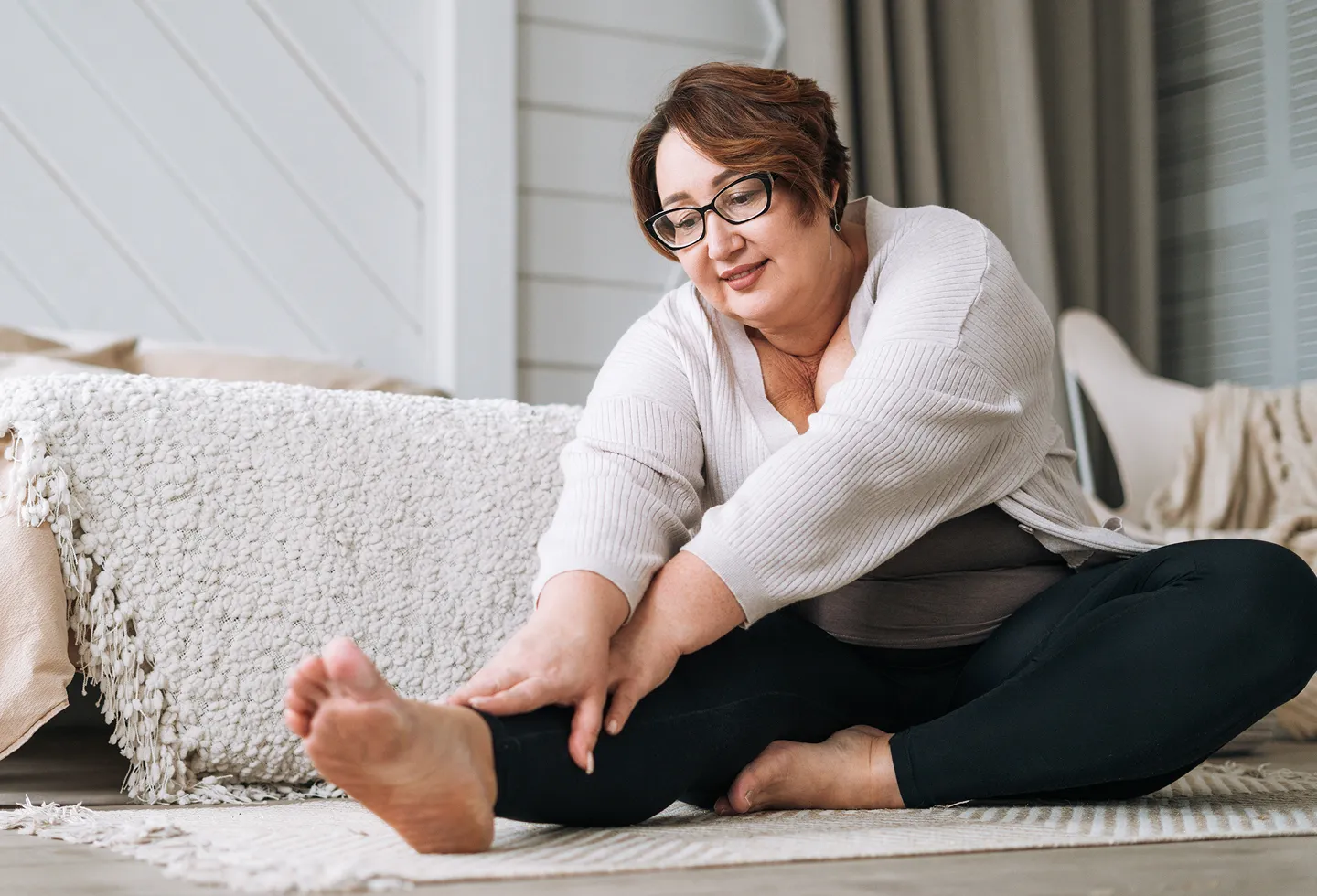
Is It Ever Too Late for Pelvic Floor Therapy?
Clinically reviewed by Liz Miracle, PT, MSPT, WCS.
No. Nope. Definitely not!
Is it ever too late to do pelvic floor exercises? Nope to this one, too. In most cases, pelvic floor exercises benefit all ages and all genders. Pelvic PT involves much more than exercises alone, but exercises are often part of the process, and you’re never too old or “too far gone” for exercise.
Let’s dive in and bust some myths about pelvic physical therapy, aging, and who can benefit from high-quality pelvic health care. (Spoiler alert: it’s pretty much everyone!)
"Pelvic floor therapy has given my mom, and myself, our lives back. With tools, expertise, and patience, Origin's excellent physical therapists prevent our pain, strengthen our muscles, and treat the things that leave us in peril currently. Cannot recommend enough. " - Audrey H., Origin patient
Am I too old to start pelvic PT?
Nope, you sure aren’t, and we can tell you that confidently without even knowing how old you are!
This is because there’s no age at which pelvic PT stops being applicable and valuable. If you have a pelvis, pelvic PT can help.
People born with vaginas in particular face biases around biological sex, age, and healthcare outcomes. Society feeds us all kinds of narratives about aging, pregnancy, the menopause transition, and more. Women listen to stories from our mothers and grandmothers, and we learn lessons like, “That’s the price we pay for having babies”, and “It’s just part of getting older”.
While there’s certainly value in learning from our elders, this is one situation in which it serves us best to move beyond the old wives’ tales. In fact, older age may even be a boon for some people seeking pelvic PT! A few examples:
- A 2019 study reviewed the charts of 335 patients referred to pelvic physical therapy. The researchers found that women aged 65 and older were more likely to attend and complete pelvic PT than their younger counterparts.
- A 2016 study assessed 169 women aged 18-70 who received education in pelvic floor muscle exercises to address stress urinary incontinence. The researchers found that iWe’ll say it again for the people in the back: No, it’s never too late to start pelvic PT. age actually predicted a better outcome with pelvic floor muscle training. (Bonus: these participants did all their treatment at home! This is even more support for the power of virtual PT care, an option many Origin patients use and love.)
While this second study couldn’t explain why older age predicted better results, the authors had an educated guess. They hypothesized that older patients may have more time to perform and stick with their assigned pelvic floor training routines. Consistency is key when it comes to any rehab routine, so it’s feasible that this was at least part of the reason!
In short, don’t count yourself out based on how many birthdays you’ve had. Your pelvic floor and other muscles don’t disappear based on a calendar date, and neither do the potential benefits you can receive from proper care.
“I have been incontinent for 5 years and in just a month of going [to PT at Origin] I no longer have to wear a pad! I am so happy I gave this a shot after spending $750 on medicines that just made me constipated! Pelvic floor therapy is real and so beneficial. I’ve learned so much about how to breathe and to tighten my abs the right way. [Pelvic PT even] helped with my chronic hip pain from rheumatoid arthritis!” - C.D., Origin Patient
Can pelvic PT still help if I’ve had symptoms for years?
You bet! Just like you’re never too old for pelvic PT, there’s no expiration date on pelvic floor symptoms, either.
In some cases, chronic symptoms—those that have been around for at least 6 months—can be more stubborn and resistant to treatment than newer problems. The research supports this: pain conditions related to the musculoskeletal system tend to improve most when patients receive care soon after the pain begins.
Chronic pain is unlikely to resolve on its own. All the more reason to seek out professionals who can help, like Origin’s physical therapists!
This pattern holds true in people with pelvic pain conditions, too. For example, male patients with chronic pelvic pain and pelvic floor problems tend to improve more with pelvic PT if their pain symptoms started recently. Most pelvic PTs will tell you that the sooner you get started in care, the better. However, they can also point to plenty of patients who lived with pelvic pain for years or decades before beginning therapy, and those patients still improved!
However, none of this means that folks with long-standing symptoms can’t improve with pelvic PT. For some, the recovery process may simply take a bit longer or be more complex than it would be for those with brand-new symptoms.
Additionally, remember that this research only applies to patients with pain conditions. Not all pelvic floor problems involve pain. As pelvic PTs, we see patients with all sorts of non-painful concerns, from bladder leaks and pelvic organ prolapse to postpartum diastasis recti and reduced sexual pleasure.
There’s less research on how chronicity affects pelvic PT outcomes for folks with these non-pain conditions. However, pelvic PTs can tell you from experience: we see plenty of people who’ve had long-standing symptoms improve under our care!
After two major excision surgeries for endometriosis and over a decade of chronic pelvic pain and tension, I truly didn’t know if I would ever feel normal again. I had so much built-up tightness in my pelvic floor and hips, and finding someone who not only understood but had the expertise to help was life-changing. -N.D., Origin patient
Is pelvic floor therapy even something I need?
There’s a common misconception that pelvic PT is only for pregnant or postpartum people, but that isn’t the case. Just as pelvic physical therapy can help address many different symptoms, it can help people with all sorts of medical histories.
I’ve never given birth. Why would pelvic PT matter to me?
Great question, and you aren’t alone in asking it!
Even if you never give birth, you may still experience symptoms of a pelvic floor disorder. For example, many people deal with pelvic floor problems during the menopause transition. Others encounter issues much earlier in life: from hemorrhoids and constipation to cancer recovery and hip surgery, pelvic PT can help with health conditions that occur across the lifespan.
Am I too young to need pelvic PT?
Heck no! There’s no age limit in either direction for when pelvic PT can help fix pelvic floor issues. In fact, some physical therapists specialize in pediatric pelvic floor therapy for young children.
Everyone who has a pelvis can struggle with pelvic floor problems. For example, teens and young adults who’ve never been pregnant may experience pain with penetrative sex, and the pelvic floor is often a contributing factor. Pelvic PT can help address this type of pelvic floor disorder, too.
Isn’t pelvic floor therapy just Kegel exercises?
Oh goodness, no. There’s so much more to the wild and wonderful world of pelvic physical therapy!
All due respect to Dr. Kegel, the gynecologist who popularized pelvic floor contractions as a treatment for incontinence, but modern pelvic health care has moved way beyond the “Kegel exercise”.
To function optimally, the pelvic floor needs so much more than raw strength. Our pelvic floor muscles need endurance, agility, flexibility, and coordination. We need them to work well with other muscles that help control the pelvis and its many functions.
In addition, your pelvic floor doesn’t exist in a vacuum. It’s part of a complex pressure control system that includes your abs, back muscles, and breathing muscles. It cooperates with your hip muscles and stabilizes your spine. Body parts as far away as your jaw can affect your pelvic floor (and vice versa).
Pelvic floor muscle exercises can certainly be valuable in certain cases, but you still might need to do more than just strengthen your pelvic floor with hundreds of Kegels.
What else do you do in pelvic PT besides strengthen your pelvic floor?
Pelvic PTs know how to treat pelvic floor dysfunction, and they do so through a whole-person approach. Your Origin PT is trained to look at the entire picture, not just your pelvic floor. In pelvic physical therapy, you can (and should!) work on all the elements that contribute to your pelvic floor problems.
Your PT may teach you pelvic floor exercises, but you’ll probably also end up stretching and strengthening other body parts, practicing breathing techniques, modifying daily habits, receiving hands-on manual therapies, and much more.
The best way to find out what’s most important for you is to see a pelvic health PT for your first visit! If you’ve been waiting and worrying about your pelvic health, consider this your sign to take the leap.
Whether you attend in person at an Origin clinic or do most of your pelvic floor PT at home through virtual care, there’s no time like the present to start feeling better about your pelvic floor.
Reach out today to book your visit with an Origin PT, and start building a personalized plan for better pelvic health at any age.
Sources Cited
- Brown, Heidi W et al. “Better together: multidisciplinary approach improves adherence to pelvic floor physical therapy.” International urogynecology journal vol. 31,5 (2020): 887-893. doi:10.1007/s00192-019-04090-w
- Lindh, Anna et al. “Non-face-to-face treatment of stress urinary incontinence: predictors of success after 1 year.” International urogynecology journal vol. 27,12 (2016): 1857-1865. doi:10.1007/s00192-016-3050-4
- Murtagh, Shemane et al. “Physiotherapy Outcomes Are Associated With Shorter Waiting Times, More Treatment Sessions and Younger Age: Analysis of a Clinical Database.” Musculoskeletal care vol. 22,3 (2024): e1924. doi:10.1002/msc.1924
- Nygaard, Ane S et al. “Baseline pain characteristics predict pain reduction after physical therapy in women with chronic pelvic pain. Secondary analysis of data from a randomized controlled trial.” Scandinavian journal of pain vol. 20,4 (2020): 793-800. doi:10.1515/sjpain-2020-0026
- Polackwich, Alan Scott et al. “Patients with Pelvic Floor Muscle Spasm Have a Superior Response to Pelvic Floor Physical Therapy at Specialized Centers.” The Journal of urology vol. 194,4 (2015): 1002-6. doi:10.1016/j.juro.2015.03.130
- van Reijn-Baggen, Daniëlle A et al. “Pelvic Floor Physical Therapy for Pelvic Floor Hypertonicity: A Systematic Review of Treatment Efficacy.” Sexual medicine reviews vol. 10,2 (2022): 209-230. doi:10.1016/j.sxmr.2021.03.002




